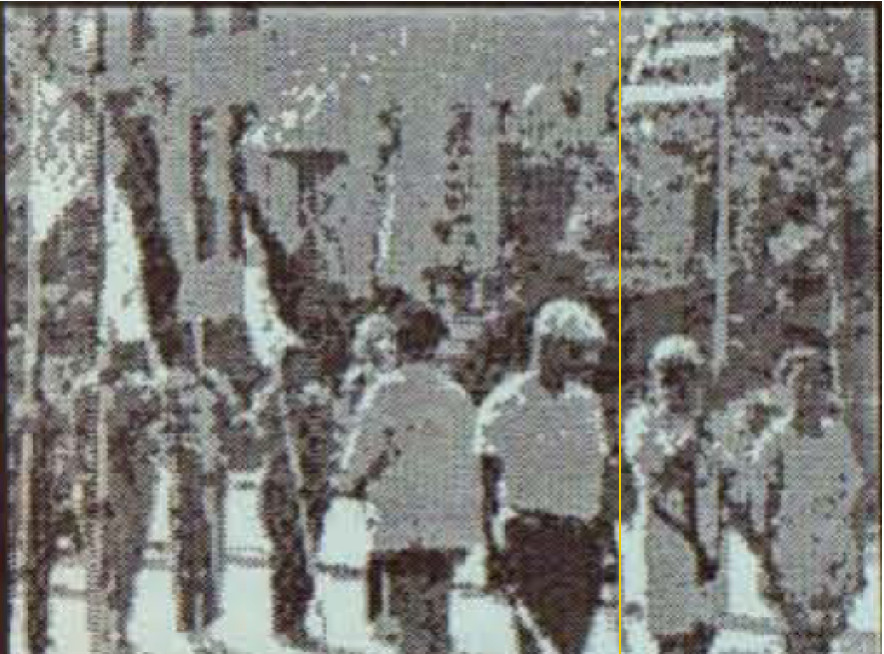
Brooklyn Day, June 6, 1991, was to be extra special this year. Lillian Wright knew this the moment she saw the Wynn Center “Toppers” Drum and Bugle Corps march from a practice session in the park of P.S. 305 onto Monroe Street where she and her little girl stood at the curb marching in time. “If I start to cry on Thursday, don’t say nothin’ ” she yelled in their direction.
For most Bedford-Stuyvesant residents, the mere sight of the Toppers recalls the 1950s, 60s and a brief period in the 70s, when this beloved drum and bugle corps was the star attraction of the Brooklyn Day parade. They were the most sophisticated corps in this annual event, started in 1829 by the Brooklyn Sunday School Union, until 1971, when personnel problems forced them to take a break.
Now they’re back, and for the first time since they left the field, all 64 members gathered together in what they call “The Ultimate Reunion.”
They came from Plattsburg, N.Y., the Bronx, Brooklyn, Jamaica, Long Island, even Atlanta, GA., for one more chance to march as they did 20 years ago.
Then, days before the event, the neighborhood was buzzing with excitement and preparation. Adults worked. Children worked. Churches worked. Every body was caught up in parade fever.
“I remember being with my friends at one or another’s house singing and polishing our boots, you know, the white ones with the tassels,” Lillian explained animatedly.
Clara Walker, owner of McDonald’s Dining Room, on Stuyvesant and Macon, remembers it all so well. “Each church had a float,” she said, “with church members floating behind it. And you’d wait for Bethany. You’d wait for Mount Lebanon. You’d want to see what Cornerstone had. It was just fantastic.”
It was endless columns of elaborate floats, marching bands, girl scouts, boy scouts, color guards and high steppin’ majorettes moving past cheering crowds lining both sides of the streets in rows 5 to 6 to 7 feet deep.
Frantically they waved flags, banners, handkerchiefs, anything to propel themselves into the euphoria, which would build as soon as they heard the familiar drum rhythms of the Topper’s corps. When they came into view, dressed in green, black and white uniforms, marching their own special steps, beating their own special beat, blowing their own special notes, the euphoria would reach a crescendo and explode into shouts and whistles and jumps ups and downs.
It was enough to make you cry; enough to make your heart burst with pride.
Yet, the Toppers did more than instill pride.
Under the leadership of its founder, Sid Austin, and his assistant, Joe Tucker, it took the kids off of the streets and developed their characters. They learned discipline, tolerance, and how to take orders. Since the Toppers was the first African-American corps to compete professionally in competitions across the nation, the youngsters learned how to deal with people of all races as well.
Regina Ashford-Boles, a 1954 Topper veteran, says “I still practice these qualities and have passed them on to my child and grandchild.”
Then there was the camaraderie; the sense of family, rounding out a program that made Douglas Smith, an original board member, realized that “If it wasn’t for the Corps, I think I would have been a junkie or a wino. But the Corps pulled me away from hanging on the corner singing doo wop songs and drinking wine.
Today, Douglas has a successful career as a Fireman. The diversity of professions, in the group, include accountants, architects, doctors, lawyers, publishers and song writers, such as Otis Blackwell who wrote songs for Elvis Presley. The list goes on as well as the efforts. Today, through its Alumni Association, the Toppers continue to help youngsters find their way.
Besides building character, the Toppers established traditions. The homecoming ritual which they performed upon their return from a competition was a jubilant occasion for their community. They would snap onto Gates Avenue from Tompkins. Triumphantly strutting to their anthem Do the Mambo, Olé, Olé.
They were a sight to behold — marching tall, backs straight, chests out. The music would echo throughout the neighborhood, drawing everyone out of their houses and onto the street. It didn’t matter what hour they returned, 11pm, midnight, or 1 am. The people just knew that the Toppers were back.
And like women welcoming their men back from war, they would run out to greet them and follow them to the Wynn Center, PAL. Near the entrance to the Center, the Toppers would pause before entering, for upwards of one half hour, marching in place, and playing popular tunes and drum solos from their repertoire.
This is how it was during the good old days. And, today? — Well, not everything is quite the same. After all, time has added other dimensions— paunches, salt and pepper manes and receding hairlines — for sure. Bulging hips too. But obviously, the spirit is still there.
Judging from the parade on Thursday, the Toppers just might be able to bring it back. The bystanders seem to hope so. From their smiles, one could say that they’re harboring the same expectations as Tim Rogers, who came to the Corps in 1964.
“On Brooklyn Day,” he says, “I expect to feel chills running through my body from my head to my toes; feel excitement from the community which has not seen us in twenty years marching down the street bringing out the flags and instruments and the people. It’s going to be a tremendous event, one that Brooklyn has been looking for, dying for, for a very long time. And it’s here, now.”
See a PDF of this ROUTES issue from June 10-16, 1991
See a list of all archived ROUTES editions
